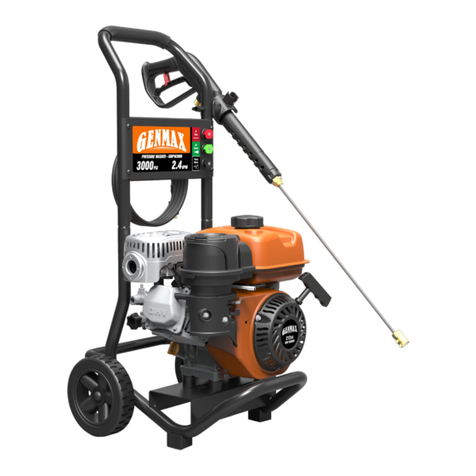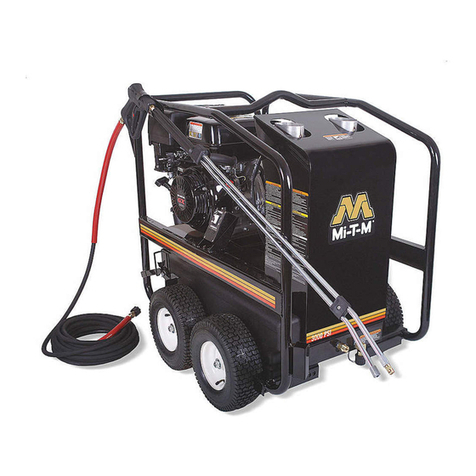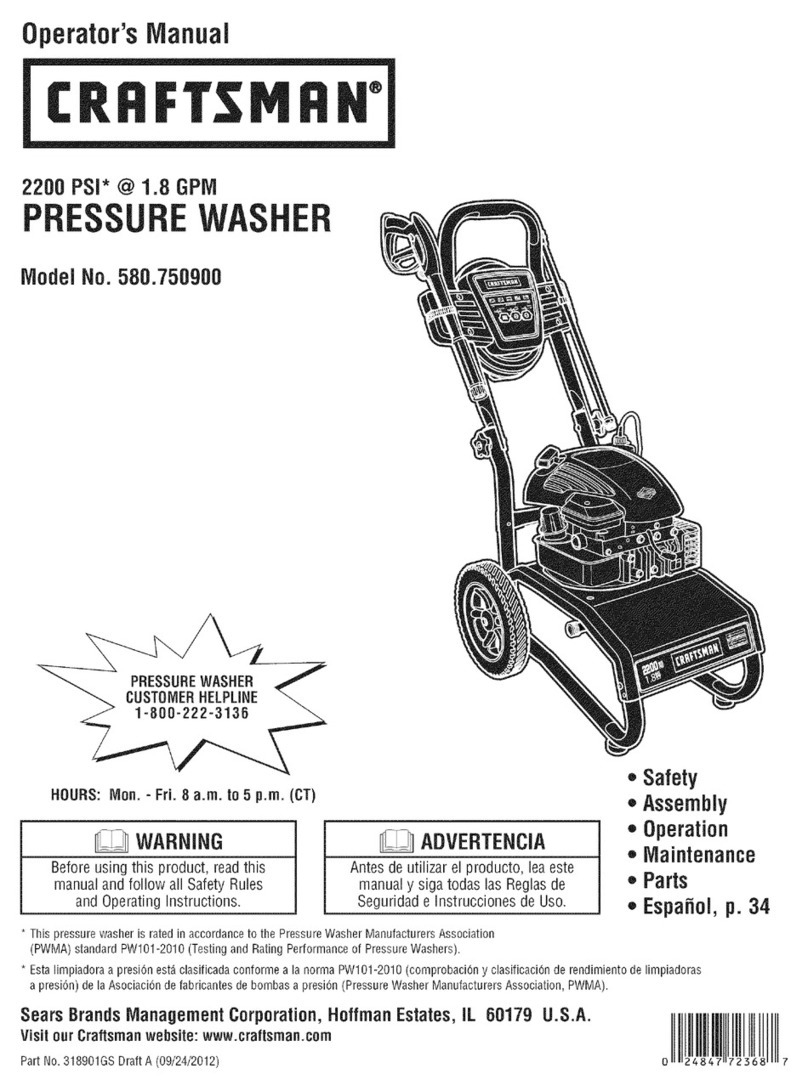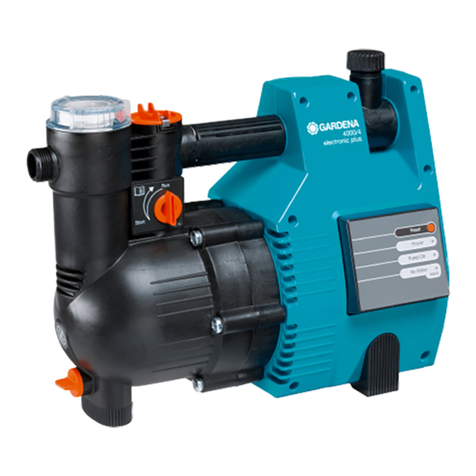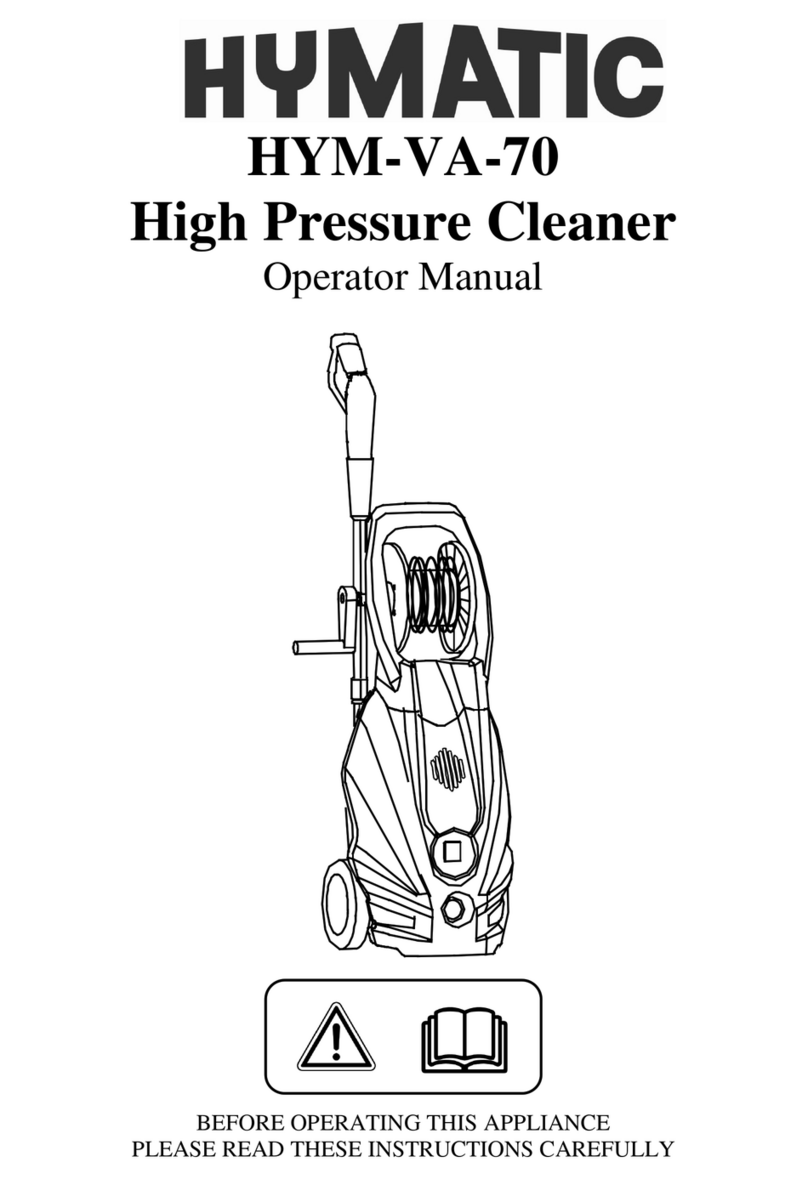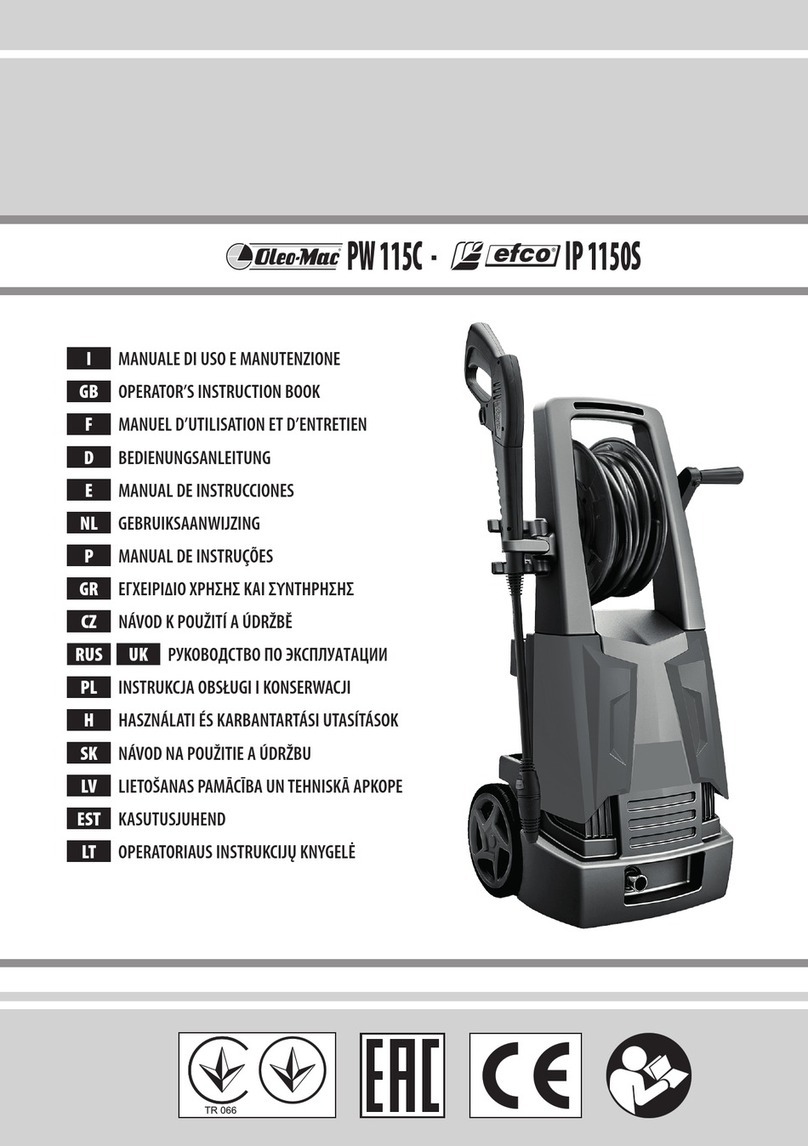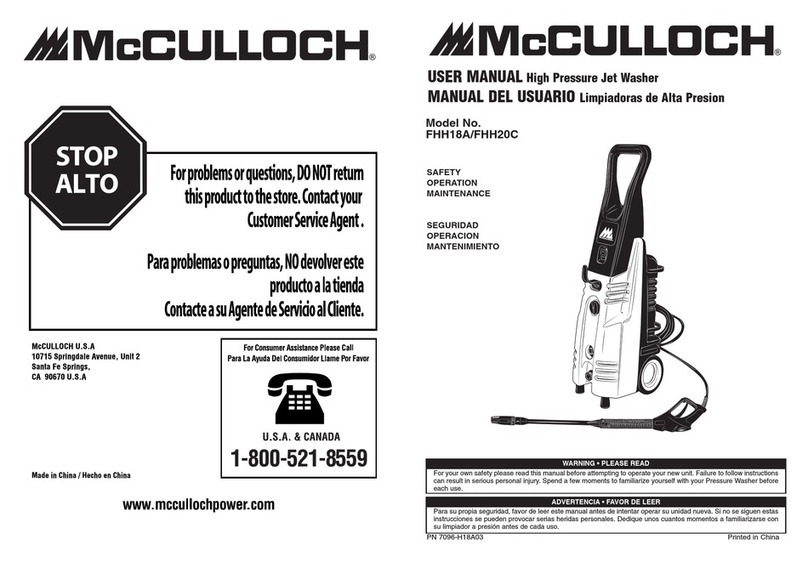GENMAX GPW2500V-E Manual

HIGH PRESSURE
WASHER
User manual
WARNING: SAVE THISMANUAL FOR FUTUREREFERENCE
This manual contains important information regarding safety. Operation,
maintenance and storage of this product. Before use, read carefully and
understand all cautions, warnings, instructions and product labels. Failure
to do so could result in serious personal injury and/or property damage.
R

CONTENTS
PRODUCT SPECIFICATIONS ............................................................................................1
SAFETY
Safety Symbols And Meanings ........................................................................................... 3
Operating Instructions and Precautions .............................................................................. 4
SETUP
Know Your Pressure Washer .............................................................................................. 10
Assembly .......................................................................................................................... 14
General Information .......................................................................................................... 17
OPERATION
Pre-start Checks ............................................................................................................... 19
Starting The Engine .......................................................................................................... 20
Pressure Washer Operation ............................................................................................. 21
Stopping The Engine And Pressure Washer .................................................................... 24
High Altitude Operation ..................................................................................................... 24
MAINTENANCE
Engine Maintenance Schedule ......................................................................................... 25
Pump Maintenance ........................................................................................................... 26
Cleaning Pressure Washer ............................................................................................... 26
Changing Engine Oil ......................................................................................................... 26
Adding Engine Oil ............................................................................................................. 27
Spark Plug Maintenance ................................................................................................... 27
Air Filter Maintenance ....................................................................................................... 28
Long-term Storage ............................................................................................................ 28
Trouble Shooting ................................................................................................................ 30

1
PRODUCT SPECIFICATIONS 1
Nozzle Type 27#(0°, 25°), soap
Starting Mode Recoil Start
PRESSURE
WASHER ENGINE
Model
Pump
MAX Pressure (PSI)
Rated Pressure (PSI)
Rated Fiow (GPM)
MAX Fiow (GPM)
High Pressure Hose (m)
Model
Displacement (cc)
Engine Type
Cooling System
Oil System
Fuel Type
Fuel Capacity (L)
Engine Oil Type
Engine Oil Capacity (L)
GPW2500V-E
Swash Plate Pump
2300
2700
2.05
2.3
7.6
1P65FE/P-1A
161
Single Cylinder 4-Stroke OHV
Air Cooled
Splash lubrication
92+ Octane Unleaded Gasoline
1.2
SAE 10W-30
0.5
GPW3000-E GPW3000-SP
29#(0°, 25°), soap
Recoil Start
2500
3000
2.1
2.4
7.6
170F/P
212
3.6
SAE 10W-30
0.6
29#(0°, 25°, 40°), soap
Recoil Start
2500
3000
2.1
2.4
7.6
170F/P
212
3.6
SAE 10W-30
0.6
Nozzle Type
29#(0°, 15°, 25°, 40°), soap
Starting Mode Recoil Start
PRESSURE
WASHER ENGINE
Model
Pump
MAX Pressure (PSI)
Rated Pressure (PSI)
Rated Fiow (GPM)
MAX Fiow (GPM)
High Pressure Hose (m)
Model
Displacement (cc)
Engine Type
Cooling System
Oil System
Fuel Type
Fuel Capacity (L)
Engine Oil Type
Engine Oil Capacity (L)
GPW3000-A
2500
3000
2.1
2.4
7.6
170F/P
212
Single Cylinder 4-Stroke OHV
92+ Octane Unleaded Gasoline
3.6
SAE 10W-30
0.6
Swash Plate Pump
Air Cooled
Splash lubrication
GPW3200-A
Recoil Start
2700
3200
2.25
2.5
7.6
170F/P-1
223
3.6
SAE 10W-30
0.6
29#(0°, 15°, 25°, 40°), soap29#(0°, 15°, 25°, 40°), soap
Recoil Start
GPW3000-B
2500
3000
2.25
2.5
10
170F/P
212
3.6
SAE 10W-30
0.6
The crankshaft pump
Swash Plate Pump

2
PRODUCT SPECIFICATIONS 1
Nozzle Type
Starting Mode
PRESSURE
WASHER ENGINE
Model
Pump
MAX Pressure (PSI)
Rated Pressure (PSI)
Rated Fiow (GPM)
MAX Fiow (GPM)
High Pressure Hose (m)
Model
Displacement (cc)
Engine Type
Cooling System
Oil System
Fuel Type
Fuel Capacity (L)
Engine Oil Type
Engine Oil Capacity (L)
Single Cylinder 4-Stroke OHV
Air Cooled
Splash lubrication
92+ Octane Unleaded Gasoline
GPW4200-A
Recoil Start/Electric
3600
4200
3.6
4
15
192FD/P-1
458
6
SAE 10W-30
1.1
40#(0°, 15°, 25°, 40°), soap
GPW3200-B
Recoil Start
2700
3200
2.7
3
15
170F/P
212
3.6
SAE 10W-30
0.6
29#(0°, 15°, 25°, 40°), soap
NOTICE: We are always working to improve our products. Therefore, final product may vary
from images shown.
The crankshaft pump The crankshaft pump

3
This Operating Manual has been designed to instruct you on the correct operation of your
product. Your satisfaction with this product and its safe operation is our ultimate concern.
Therefore, please take the time to read the entire manual, especially the safety symbols
and instructions They will help you to avoid potential hazards that may exist when working
with this product. Every effort has been made to ensure that information in this manual is
accurate and current. However, we reserve the right to change, alter, or otherwise improve
the product and this document at any time without prior notice.
Fire
Explosion
Electrical Shock
Projectile
Chemical Burns
Electrical Hazard
Slippery Surface
Fall
Safety Alert
Read Operators Manual
Asphyxiation Hazard
Eye Protection
Hot Surface
Fluid Injection
Kickback
Moving Parts
SAFETY 2
Safety Symbols and Warnings:
DANGER: indicates a hazard which, if
not avoided, will result in death or serious
injury.
WARNING: indicates a hazard which,
if not avoided, could result in death or
serious injury.
Safety symbols and their meanings:
The following symbols will appear in this manual and on the product. For safe use of this
product,be sure to study them and know their meanings.
CAUTION: indicates a hazard which,
if not avoided, could result in minor or
moderate injury.
NOTICE: Indicates information, or
addresses practices that are important, but
not related to personal injury.
1

4
Important Operation Instructions and Precautions:
DANGER: POISONOUS GAS HAZARD
Engine exhaust contains carbon monoxide, a poisonous gas that WILL kill you
in minutes. You CANNOT smell it, see it, or taste it. Even if you do not smell
exhaust fumes, you could still be exposed to carbon monoxide gas. Some chemicals or
detergents could also be harmful if inhaled or ingested, resulting in death, serious injury,
nausea, fainting or poisoning.
• Operate this product ONLY outside far away from windows, doors and vents to
reduce the risk of carbon monoxide gas from accumulating and potentially being
drawn towards occupied spaces.
• DO NOT run this product inside homes, garages, basements, crawlspaces, sheds, or
other partially enclosed spaces, even if using fans or opening doors and windows for
ventilation. Carbon monoxide can quickly build up in these spaces and can linger for
hours, even after this product has been shut off.
• ALWAYS place this product downwind and point the engine exhaust away from
occupied spaces.
If you start to feel sick, dizzy, or weak while using this product, shut it off and get to
fresh air RIGHT AWAY. See a doctor, as you may have carbon monoxide poisoning.
•
SAFETY 2
1

5
WARNING: READ AND UNDERSTAND ALL SAFETY INSTRUCTIONS
• Keep guards in place and in working order. Never operate this product with any guard or
cover removed. Make sure all guards are intact and operating properly before each use.
• Remove adjusting tools and wrenches. If any adjustments or maintenance has been
performed, make sure that all tools and adjusting wrenches are removed from product
before use.
• To reduce the risk of injury, keep all children and visitors away from product when in use.
All visitors should wear safety glasses and be kept a safe distance from work area.
• Keep the work area clear of all persons, particularly small children, and pets.
• Use product for its intended use. Don' t force product or attachment to do a job it was not
designed for. Do not use it for a purpose not intended. Use only recommended accessories
with this product. The use of improper and or modified accessories may cause risk of injury.
• Use proper clothing. Wear long pants and long sleeves. Do not wear loose clothing,
neckties, or jewelry. They can get caught and draw you into moving parts. Rubber gloves
and nonskid footwear are recommended when working outdoors. Do not operate the
equipment while barefoot or when wearing sandals or similar lightweight footwear Also
wear protective hair covering to contain long hair.
• Always wear proper eye protection with side shields marked to comply with ANSI Z87.1.
Following this rule will re-duce the risk of serious personal injury.
• Do not overreach or stand on a ladder, rooftop, or other unstable support structure. Keep
proper footing and balance at all times.
• Never leave product running unattended. Turn power off. Don' t leave product until it
comes to a complete stop.
• Keep the engine and pump free of grass, leaves, oil, or grease to reduce the chance of a
fire hazard.
• Keep the exhaust outlet free of foreign objects.
• Be completely knowledgeable with product controls. Know how to stop the product and
bleed pressure quickly.
• Stay alert and exercise control. Watch what you are doing at all times and use common
sense. Do not operate tool when you are tired. Do not rush.
• Do not operate the product while under the influence of drugs, alcohol, or any
medication.
• Check the work area before using product. Remove all objects such as rocks, broken
glass, nails, wire, or string which can be thrown or become tangled in the product.
• Do not direct high pressure spray stream at any persons, animals and pets. Do not direct
spray stream.
• Never lift or carry the product or attempt to make adjustments while the engine is running
or hot.
• Do not attempt to touch the spark plug or plug wire while the engine is running.
• Use only cold water with this product.
• For outdoor use only.
SAFETY 2
1

6
WARNING: Fire / Hot Surface Hazard
• DO NOT touch hot parts and AVOID hot exhaust gases.
• Allow equipment to cool before touching.
• Keep at least 5 feet (1.5 m) of clearance on all sides of pressure washer including
overhead.
• Replacement part must be the same and installed in the same position as the original.
WARNING: Slip or Fall Hazard
Use of pressure washer
could create slippery
surfaces causing you to fall resulting in
death or serious injury.
• Kickback from spray gun could cause
you to fall resulting in death or serious
injury.
• Operate pressure washer from a
stable surface.
• The cleaning area should have
adequate slopes and drainage to
reduce the possibility of a fall due to
slippery surfaces.
• Be extremely careful if you must use
the pressure washer from a ladder,
scaffolding, or any other similar
location.
• Firmly grasp spray gun with both
hands when using high pressure
spray to avoid injury when spray gun
kicks back.
WARNING: Kickback Hazard
Starter cord kickback (rapid
retraction) will pull hand and
arm toward engine faster than you can
let go, which could cause fractures,
bruises, or sprains resulting in serious
injury.
•
NEVER pull starter cord without first
relieving spray gun pressure.
When starting engine, pull cord slowly
until resistance is felt and then pull
rapidly to avoid kickback.
After each starting attempt, where
engine fails to run, always point spray
gun in safe direction, disengage trigger
lock and squeeze spray gun trigger to
release high pressure.
Firmly grasp spray gun with both
hands when using high pressure spray
to avoid injury when spray gun kicks
back.
•
•
•
SAFETY 2
1
Exhaust could ignite combustibles, resulting in death or serious injury.
Contact with muffler area could cause burns resulting in serious injury.

7
WARNING: Fire / Explosion Hazard
Fuel and its vapors are extremely flammable and explosive which could
cause burns, fire or explosion resulting in death or serious injury.
Risk of fire and serious burns: Never remove fuel cap when unit is running. Shut off
engine and allow the unit to cool at least five minutes. Remove cap slowly.
WHEN ADDING OR DRAINING FUEL
• Turn pressure washer engine OFF and let it cool at least 2 minutes before removing
fuel cap. Loosen cap slowly to relieve any pressure remaining in tank.
• Fill or drain fuel tank outdoors.
• DO NOT overfill tank. Allow space for fuel expansion.
• If fuel spills, wait until it evaporates before starting engine.
• Keep fuel away from sparks, open flames, pilot lights, heat, and other ignition sources.
• Check fuel lines, tank, cap and fittings frequently for cracks or leaks. Replace if
necessary.
• DO NOT light a cigarette or smoke.
WHEN STARTING EQUIPMENT
• Ensure spark plug, muffler, fuel cap, and air filter are in place.
• DO NOT crank engine with spark plug removed.
WHEN OPERATING EQUIPMENT
• DO NOT operate this product inside any building, carport, porch, mobile equipment,
marine applications, or enclosure.
• DO NOT tip engine or equipment at angle which causes fuel to spill.
• DO NOT spray flammable liquids.
WHEN TRANSPORTING, MOVING OR REPAIRING EQUIPMENT
• Transport/move/repair with fuel tank EMPTY or with fuel shutoff valve OFF.
• DO NOT tip engine or equipment at angle which causes fuel to spill.
• Disconnect spark plug wire.
WHEN STORING FUEL OR EQUIPMENT WITH FUEL IN TANK
Store away from furnaces, stoves, water heaters, clothes dryers, or other appliances
that have pilot light or other ignition source because they could ignite fuel vapors.
WARNING: Fire and Electrical Shock
Unintentional sparking could cause fire or electric shock, resulting in death or
serious injury.
WHEN ADJUSTING OR MAKING REPAIRS TO YOUR PRESSURE WASHER
• Disconnect the spark plug wire from the spark plug and place the wire where it cannot
contact spark plug.
WHEN TESTING FOR ENGINE SPARK
• Use approved spark plug tester.
• DO NOT check for spark with spark plug removed.
SAFETY 2
1

8
WARNING: Fluid Injection
The high-pressure water that
this equipment produces could
cut through skin and its underlying
tissues, resulting in serious injury and
possible amputation.
• Spray gun traps high water pressure,
even when engine is stopped and
water is disconnected, which could
result in serious injury.
• If cut by fluid, call physician
immediately. DO NOT treat as a
simple cut.
• DO NOT allow CHILDREN to operate
pressure washer.
• NEVER repair high pressure hose.
Replace it.
• NEVER repair leaking connections
with sealant of any kind. Replace
o-ring or seal.
• NEVER connect high pressure hose
to nozzle extension.
• Keep high pressure hose connected
to pump and spray gun while system
is pressurized.
• ALWAYS point spray gun in safe
direction, disengage trigger lock and
squeeze spray gun trigger to release
high pressure, every time you stop
engine.
• NEVER aim spray gun at people,
animals, or plants.
• DO NOT secure spray gun in open
position.
• DO NOT leave spray gun unattended
while machine is running.
• NEVER use a spray gun which does
not have a trigger lock or trigger guard
in place and in working order.
• Always be certain spray gun, nozzles
and accessories are correctly
attached.
WARNING: Moving parts hazard
Starter and other rotating parts
could entangle hands, hair,
clothing or accessories, resulting in
serious injury.
• NEVER operate pressure washer
without protective housing or covers.
• DO NOT wear loose clothing, jewelry
or anything that could be caught in the
starter or other rotating parts.
• Tie up long hair and remove jewelry.
WARNING: Projectile hazard
Risk of eye or bodily injury.
Spray could splash back or
propel objects resulting in serious injury.
• Always wear safety goggles marked to
comply with ANSI Z87.1 when using or
in vicinity of this equipment.
• Always wear protective clothing such
as a long-sleeved shirt, long pants and
close-toed shoes.
• NEVER operate pressure washer
when barefoot or wearing sandals.
CAUTION: Engine Speed
Excessively high operating speeds could
result in minor injury. Excessively low
speeds impose a heavy load on engine.
• DO NOT tamper with governor spring,
links or other parts to increase engine
speed. Pressure washer supplies
correct rated pressure and flow when
running at governed speed.
• DO NOT modify pressure washer in
any way.
SAFETY 2
1

9
NOTICE: For additional information
regarding the parts listed in
the following pages, refer to:
• PARTS LIST AND DIAGRAM on
Page 29.
WARNING: Electrical Shock
Contact with power source could
cause electric shock or burn
resulting in death or serious
injury.
• Never spray at or near an electric
power source.
WARNING: Chemical Burn
Chemicals could cause burns
resulting in death or serious
injury.
• DO NOT use caustic liquid with
pressure washer.
• Use ONLY pressure washer safe
detergents/ soaps. Follow all
manufacturer’ s instructions.
WARNING: California Proposition 65
This product, the engine exhaust and other substances that may become airborne from
its use contains chemicals, including lead, known to the State of California to cause
cancer, birth defects, or other reproductive harm. Wash your hands after handling
product.
NOTICE: High pressure spray could
damage fragile items including
glass.
• DO NOT point spray gun at glass when
using red (0°) nozzle.
• NEVER aim spray gun at plants.
NOTICE: Improper treatment of pressure washer could damage it and shorten its life.
• NEVER operate units with broken or missing parts, or without protective housing or
covers.
DO NOT by-pass any safety device on this machine.
DO NOT tamper with governed speed.
DO NOT operate pressure washer above rated pressure.
DO NOT modify pressure washer in any way.
Before starting pressure washer in cold weather, check all parts of the equipment to
be sure ice has not formed there.
NEVER move machine by pulling on hoses. Use handle provided on unit.
•
•
•
•
•
•
SAFETY 2
1

10
SETUP
CAUTION: Read Manual
Read the entire SAFETY section at the beginning of this manual including all text
under subheadings therein before set-up or use of this product.
High pressure washer component identification
2
1
Handle
Trigger
Panel
Nozzle
Spray Gun
Pressure Hose
Pump
Muffler
Recoil Handle
Wheel
Wand
Fuel Tank
Air filter
GPW2500V-E

11
SETUP 2
1
High pressure washer component identification
GPW3000-E
Trigger
Handle
Panel
Spray Gun
Nozzle
Wand
Recoil Handle
Air filter
Wheel
Fuel Tank
Pressure Hose
Pump
GPW3000-SP
Trigger
Handle
Panel
Spray Gun
Nozzle
Wand
Recoil Handle
Air filter
Wheel
Fuel Tank
Pressure Hose
Pump
Muffler
Muffler

12
SETUP 2
1
High pressure washer component identification
GPW3000-B
GPW3200-A
Trigger
Handle
Spray Gun
Nozzle
Panel
Wand
Pressure Hose
Pump
Wheel
Recoil Handle
Air filter
Muffler
Wheel
Recoil Handle
Air filter
Muffler Panel
Nozzle
Handle
Pressure Hose
Wand
Pump
Spray Gun
Trigger

13
SETUP 2
1
High pressure washer component identification
GPW4200-AE
Handle Trigger
Spray Gun
Nozzle
Panel
Pressure Hose
Wand
Pump
Wheel
Air filter
Fuel Tank
Muffler
Soap Box

14
SETUP 2
1
ASSEMBLY:
1. Installation method of hose support:
a. Insert the hose holder (A) through holes
in the panel (B).
b. Pass hose support (A) through handle
hole (B) and tighten nut (C).
2. Panel Installation Method:
a. b. c. b. Pass the panel bolt (A) through
the handle hole (B) and tighten the bolt.
B
A
B
c.
A
A
B
a.
d.
B
A
b.
A
B
a.
b.
AB
C
3. Installation method of gun hook:
a. Pass the gun hook (A) through the
handle hole (B) and tighten the nut (C).
b. Pass bolt (A) through hook and handle
hole (B) and tighten.
a.
A
B
C

15
SETUP 2
1
b.
A
B
4. Push the nozzle (A) into the panel
nozzle hole (B)
B
A
B
A
5.Push and hold the button on the frame(B)
as you slide the handle(A) out the holes in
the frame, rotate 180°, then push and hold
the button on the frame as you slide the
handle into the frame.
A
B
6. High pressure hose connection method:
a. Insert the high-pressure hose (A) into the
hose connector (B) and tighten the hose
elastic ring (C) .
b. Attach high pressure hose(A) to the
pump(D), pull back the quick-connect
collar(C) of pump, insert hose connector(B)
and then release the quick-connect collar,
pull on the hose to make sure it is firmly
attached.
b.
B
A
a.
C
7. Connecting method of water supply
hose:
a. b. Connect the water supply hose (A) to
the inlet pipe connector (B) of the pump
and tighten the inlet pipe connector by
hand.
b.
a.

16
SETUP 2
1
8.Connecting method of spray gun:
a. Attach high pressure hose(D) to the
gun(A), pull back the quick-connect
collar(C) of hose and insert the spray
gun connector(B) and then release the
quick-connect collar(C). Once the hose
is connected, pull on the hose to make
sure it is firmly attached.
b. Attach high pressure hose(D) to the
gun(A),Connect the spray gun connector
(B) to the hose connector (C) and
tighten the threaded connector (C).
a. A
B
C
D
A
B
C
D
b.
9. Remove the protective cap on the
Wand inlet. Insert the Wand into the
Spray Gun tip and tighten the nut firmly
by hand.
Wand
Spray Gun Tip
10. Attach the Nozzle to the Wand by
pulling back the quick connect collar and
pushing the Nozzle onto the end of the
Wand. Make sure the quick connect
collar locks the Nozzle in place.
Nozzle
Wand
Quick Connect
Collar
GENERAL INFORMATION:
Fuel Use fresh high-quality unleaded gasoline (minimum 87 octane),
containing up to 10% ethanol.
Do not use fuel with high ethanol content; E15 or E85.
Oil Engine oil: Use only SAE 10W-30, 0.6 Quart non-detergent oil
(supplied).
Pump Oil: The pump was lubricated and sealed at the factory, and is
maintenance free for the life of the product, under normal operation. Do
not attempt to change or add oil to the pump.

17
Water Use only cold water.
Do not operate pressure washer with clogged or missing water inlet filter
screen.
Do not operate pressure washer without adequate water supply.
Pressure
Adjustment
Pressure setting is pre-set at factory.
For lowering pressure, refer to“Pressure Adjustment" on Page 18.
High Pressure
Pump
There are no serviceable parts to the high-pressure pump. Do not
attempt to repair or service the pump, as you may damage it and void
your warranty. If you feel that the pump needs service, please submit to
an authorized dealer.
Do not allow water to freeze in pump. If product is stored in an area
that will have temperatures of below 32° F, 0°C, make sure all water is
removed from the pump, or a suitable pump protection product has been
used. Failure to protect the pump form cold temperatures will cause
damage and possibly void your warranty.
By-pass
Mode
When you release the trigger of the gun, the pump goes into bypass
mode. It is good practice to never let the pump run in bypass mode for
more than 2 minutes. Damage to pump could be possible.
Thermal
Relief Valve
Pump is equipped with a thermal relief valve. If during bypass mode the
water overheats, this valve opens releasing the hot water and letting
new cool water enter the pump. Afterwards, the valve closes returning
pump to normal operation. Caution, the valve opens with no warning,
and the water will be hot. Possible injury can occur. Always keep hands
and feet away from thermal relief valve.
Do not allow hoses to come in contact with engine muffler during use or
immediately after use.
DO NOT attempt to move unit by pulling on high-pressure hose.
High Pressure
Hose
Engine Do not adjust or attempt maintenance without reading owner's manual.
Add fuel stabilizer (not supplied) to fuel tank and let engine run for 5
minutes before storage. Always turn on water before starting engine.
Soap /
Chemicals
Use only soaps and chemicals detergents designed for pressure
washer use. Always follow detergent manufacturer's instructions on
their container. DO NOT use bleach, acid, any flammable materials, or
industrial solvents.
Nozzle Always keep nozzles clean and unclogged. Use the nozzle needle
to clean if clogged. Use ONLY detergent nozzle (black) when using
chemical and cleaning solvents.
Storage /
Winterizing
Run clean water through chemical tank / inlet to clear any residual
detergent. Add stabilizer to any remaining fuel in fuel tank. See ENGINE
section above. Do not allow water to freeze in pressure pump, spray
gun, spray wand or hoses.
GENERAL INFORMATION:
SETUP 2
1

18
OPERATION
1. Adding Engine Oil
1.1 Move the Pressure Washer OUTSIDE
and place on a flat and level surface.
1.2 Make sure the engine is stopped, cool
and is level.
1.3 Close the Fuel Valve.
1.4 Clean the top of the Dipstick and the
area around it. Remove the Dipstick
by turning it counterclockwise, and
wipe it off with a clean, lint free rag.
1.5 Place a funnel in the oil reservoir.
1.6 Pour engine oil(SAE 1 0W-30 is
recommended for general use).
CAUTION: Read Manual
Read the entire SAFETY and SET UP sections at the beginning of this manual
including all text under subheadings therein before operation of this product.
Improper use or treatment of Pressure Washer can damage internal components and
shorten the life of unit. Failure to follow this warning will void warranty.
DO NOT overfill. Consult the separate
engine manufacturers manual if
available. See figure A
section shows other viscosities to use
1.7 Reinsert the Dipstick without threading
it in and remove it again to check the
oil level. The oil level should be up to
the full level as shown above.
1.8 If the oil level is at or below the low
mark, add the appropriate type of
oil until the oil level is at the proper
level. (The SAE Viscosity Grade Chart
on page 22 in the MAINTENANCE
section shows other viscosities to use
in different average temperatures. )
1.9 Replace the dipstick and fully tighten.
Pre-Start Checks
Inspect engine and equipment looking for damaged, loose and missing parts before setting
up and starting.
Figure A
NOTICE: Your Warranty is VOID if the engine's crankcase is not properly flled with oil
before each use. Before each use, check the oil level. Your engine may be equipped with a
low-oil shutdown feature. If so equipped, the engine will not start with low or no engine oil in
the crankcase.
2
1
This manual suits for next models
7
Table of contents
Other GENMAX Pressure Washer manuals
Popular Pressure Washer manuals by other brands

Kärcher
Kärcher K 3 Premium operating instructions

Anova
Anova H2200 Installation instructions & user manual
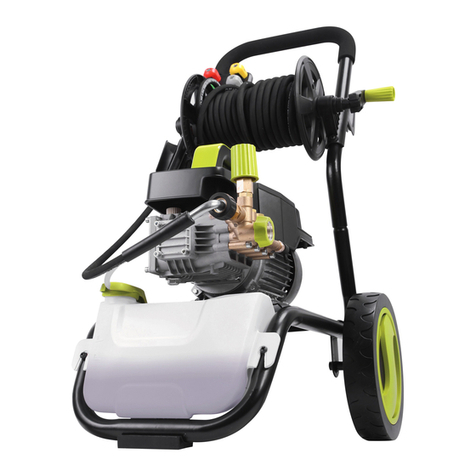
SNOWJOE
SNOWJOE SPX9009-PRO Operator's manual
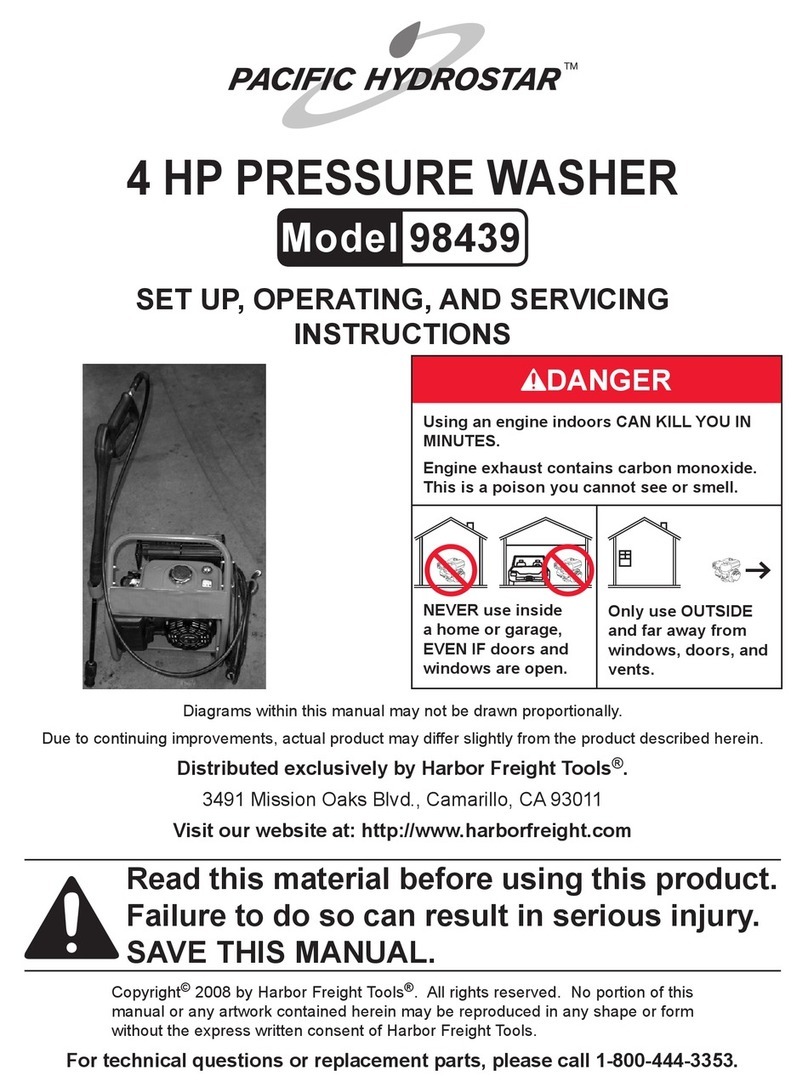
Pacific hydrostar
Pacific hydrostar 98439 Set up, operating, and servicing instructions
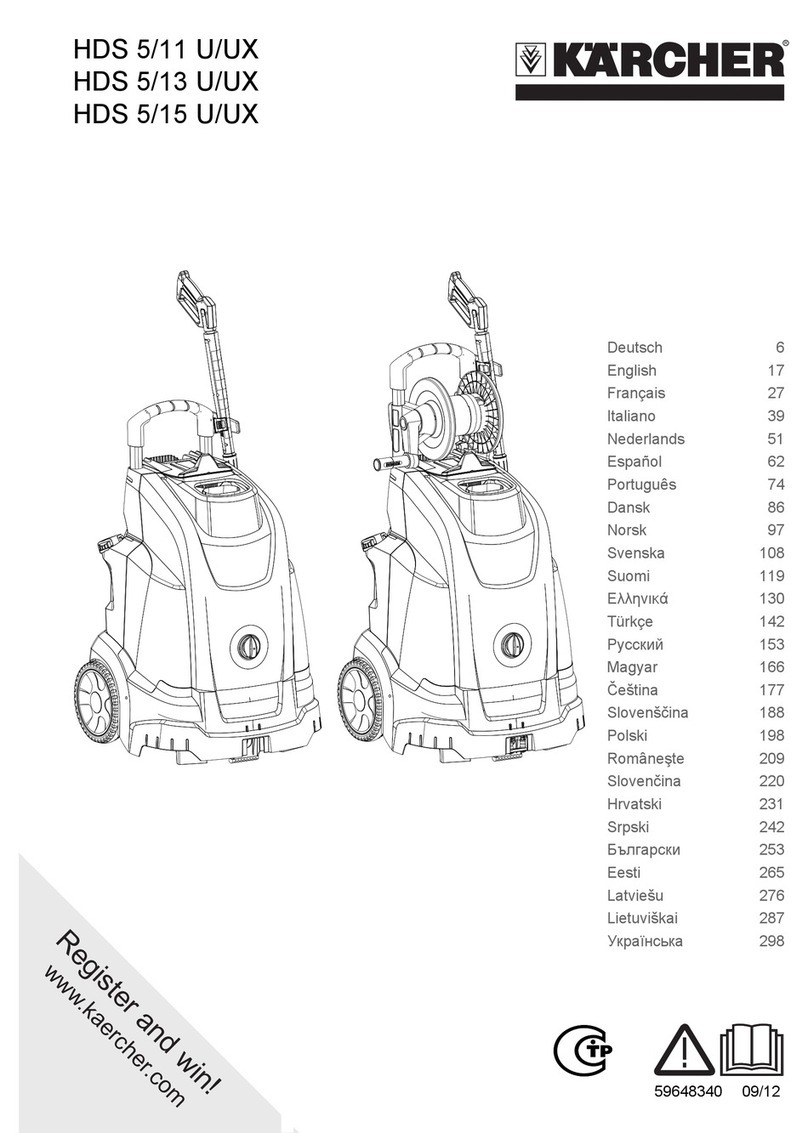
Kärcher
Kärcher HDS 5/11 U/UX instructions
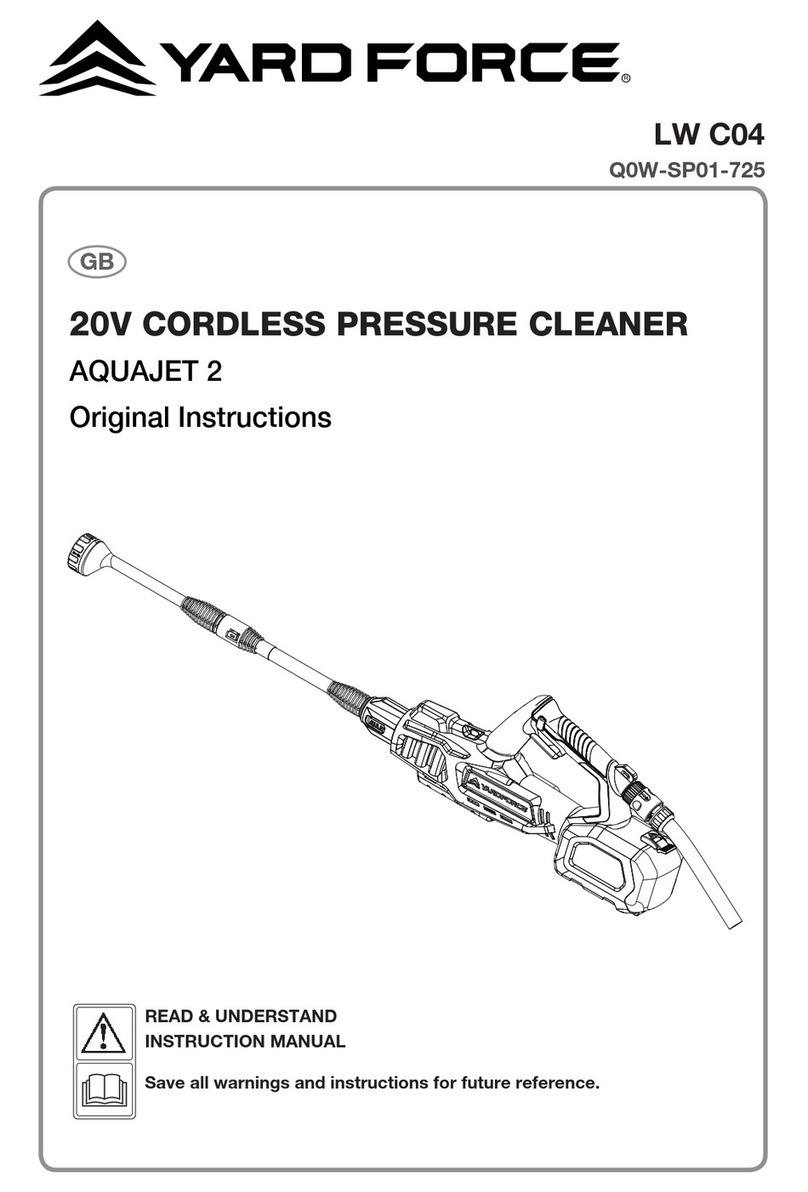
Yard force
Yard force AQUAJET 2 Original instructions
